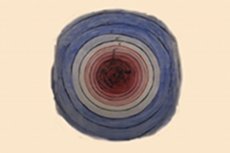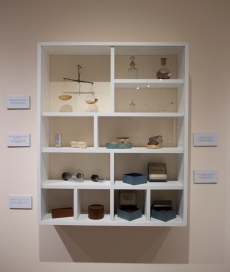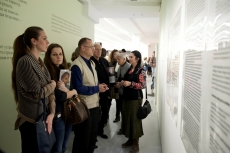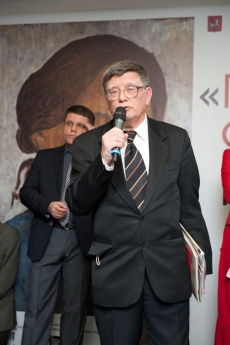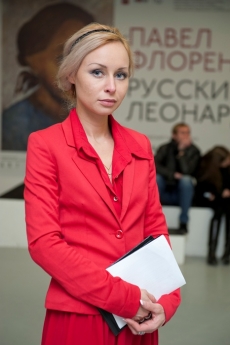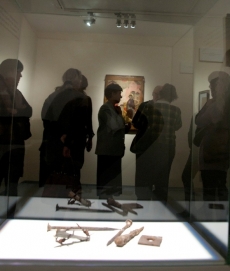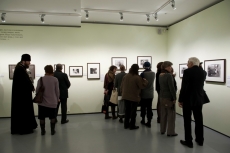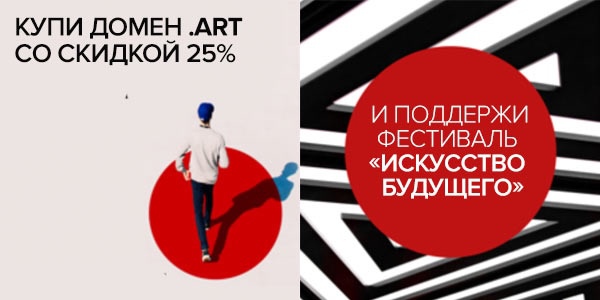Pavel Florenskiy - Russian Leonardo
V.A. Komarovsky. The portrait of priest Pavel Florensky. 1924. Wood, tempera, oil
P.A. Florensky. The scheme of the territorial migration of ancient philosophy. From the album of illustrations to the classical Greek philosophy course. 1908-1909. Paper, watercolor, pencil, ink
P.A. Florensky. From the “Imaginary in geometry” illustrations. 1922. Paper, ink
Moscow, 23.11.2012—16.12.2012
exhibition is over
Share with friends
Father Pavel Florensky is rightfully called ’the Russian Leonardo da Vinci’. A brilliant thinker and scholar, engineer and inventor, he made an important contribution to philosophy, theology, philology, art history, mathematics, physics, ethnography, museology, electrotechnics and geology. The diversity of talents and creative interests shown by this 20th-century Russian polymath is extraordinary.
For the press
Pavel Alexandrovich Florensky was born on 9 (in the Church calendar, 22) January 1882, near Yevlakh (now part of Azerbaijan), into the family of a railroad engineer. His childhood and youth were spent in Georgia.
In 1900 he finished the 2nd Gymnasium in Tiflis with a gold medal and entered the physico-mathematics faculty of Moscow University. His teachers included well-known scholars and professors: B.K. Mlodzeyevsky, L.K. Lakhtin, N.Ye. Zhukovsky and S.N. Trubetskoi. He was particularly influenced by Professor N.V. Bugaev, one of the founders of the Moscow school of mathematics. During his university studies P.A. Florensky became friendly with the poet A. Bely (son of N.V. Bugaev), and through him met the Symbolists V.Ya. Bryusov, K.D. Balmont, D.S. Merezhkovsky, Z.N. Gippius and A.A. Blok. But it soon became clear that there were profound personal and ideological differences between P.A. Florensky and the majority of Symbolists. Although considered one of the most talented students, a promising future scientist, after graduating from Moscow University with honours P.A. Florensky entered the Moscow Theological Academy in the spring of 1904. Thereafter his whole life was closely linked to the Trinity-St. Sergius Monastery, beside whose walls he lived for almost 30 years.
P.A. Florensky was appointed as professor of the Moscow Theological Academy, where he taught the history of philosophy
P.A. Florensky wrote prolifically about the pan-European spiritual crisis in which Russia too had become entangled, often speaking of its imminent downfall due to a loss of spiritual and national principles. For him the Revolution was not unexpected. His view was that the establishment of Soviet power was naturally determined and irreversible before the time was right, therefore everything it brought in its wake should be accepted, apart from atheism. Hence Father Pavel displayed genuine political loyalty to the Soviet regime, although he was ideologically opposed to the dissemination of atheistic doctrine. ’Testament’, begun on 11 April 1917, proves that he foresaw both the ordeal ahead for Russia, and his own tragic fate.
After the Revolution he refused to relinquish his holy orders or emigrate, responding with the words of the Apostle Paul: ’Be content with what you have’. He wanted to share the fate of his people, and of Russia as a whole, to the very end, in every respect. ’Father Pavel was organically unable and unwilling to become an emigrant in the sense of voluntary or involuntary removal from his native land, and he himself, and his fate, denote the greatness and glory of Russia, but at the same time a very grave crime’ (archpriest Sergy Bulgakov).
From October 1918 to May 1920 P.A. Florensky was custodian of the monastic diaconicon and secretary-scholar to the Commission for Protection of Monuments of Art and Antiquity at the Troitse-Sergieva Lavra, subordinate to the museums department of the People’s Commissariat for Enlightenment. At this period the Lavra’s nationalised treasures were in danger of being looted, destroyed and irrevocably lost. Due to the Commission’s activities this national property of immeasurable cultural and material value was saved. In his work for the Commission Fr. Pavel Florensky was one of the first in world practice to develop the idea of a ’living museum’, demanding the preservation of each object in the surroundings and context in which it first appeared and existed. However, in the conditions of the 1920s and the following years the attempt to preserve the Troitse-Sergieva Lavra and Optina Pustyn as living centres of spiritual culture was doomed; time only confirmed the truth behind Fr. Pavel’s convictions and endeavours.
In the 1920s P.A. Florensky worked for various state organisations engaged in research. He was editor of the ’Technical Encyclopaedia’, worked in teaching and scientific institutions, and in the industrial sector (RSFSR Supreme Soviet of the National Economy Main Electrotechnical Administration; Karbolit plant). Merely his appearance there in a cassock represented a challenge to state atheism and an obvious refutation of the alleged ’ignorance and illiteracy’ of the priesthood. Fr. Pavel’s numerous inventions and discoveries in the sphere of natural and technical sciences were far ahead of their time.
In August 1921 Fr. Pavel Florensky was confirmed as professor of the printing and graphics faculty at the Higher Art and Technology Workshops (VKhUTEMAS), where for the next 3 years he gave a course of lectures entitled ’Analysis of Perspective’. Together with like-minded thinkers V.A.Favorsky and P.Ya. Pavlinov, he advocated the value and importance of cultural forms common to all mankind that bear spiritual significance. P.A. Florensky pointed out the detrimental effect of linear perspective as an artistic method of depicting space and introduced the concept of ’reverse perspective’, which has particular meaning in icon-painting. His activities at VKhUTEMAS were subject to harsh criticism from the Constructivists and ideologists of the Left Front of the Arts. During this period Florensky participated in the activities of the Moscow Institute of Art Research and Museology, and also worked with the Makovets group of artists and poets.
Outstanding philosophers, writers, artists and musicians highly valued their friendship with Florensky: S. Bulgakov, V. Rozanov, A. Losev, A. Bely, V. Khlebnikov, M. Voloshin, M. Nesterov, V. Favorsky, M. Yudina, etc.
In 1928 Fr. Pavel Florensky was arrested and transported to Nizhny Novgorod. After his return from exile (the same year) he worked at the State Experimental Electrotechnical Institute. In 1933 he was accused of counterrevolutionary activity and exiled to the Far East, before being transferred in 1934 to the Solovetsky special-purpose camp. On 8 December 1937 Father Pavel Florensky was executed by firing squad. His burial site is presumed to be in the Leningrad region.
Archpriest Sergy Bulgakov wrote of his friend: ’I knew him as a mathematician, physicist, theologian, philologist, philosopher, religious historian, poet, connoisseur and admirer of art, as well as a profound mystic. His spiritual focus, the radiance that illuminated all his gifts, was his priesthood. Of all my contemporaries, among all those I was fated to meet in the course of a long life, he is the greatest, and great is the crime of those who laid hands on him. He departed, illumined by the aureole not simply of a martyr, but of a confessor in the name of Christ at a time of anti-Christian persecution’.
Our grateful thanks for support and assistance to:
State Historical Museum

